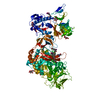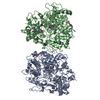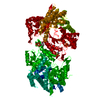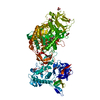[English] 日本語
 Yorodumi
Yorodumi- PDB-6vx4: Density-fitted Model Structure of Antibody Variable Domains of Ty... -
+ Open data
Open data
- Basic information
Basic information
| Entry | Database: PDB / ID: 6vx4 | ||||||||||||
|---|---|---|---|---|---|---|---|---|---|---|---|---|---|
| Title | Density-fitted Model Structure of Antibody Variable Domains of TyTx11 in Complex with Typhoid Toxin | ||||||||||||
 Components Components |
| ||||||||||||
 Keywords Keywords | TOXIN / Typhoid Toxin / A2B5 / Antibody / Fab | ||||||||||||
| Function / homology |  Function and homology information Function and homology informationTransferases; Glycosyltransferases; Pentosyltransferases / NAD+ poly-ADP-ribosyltransferase activity / toxin activity / endonuclease activity / Hydrolases; Acting on ester bonds / hydrolase activity / extracellular region Similarity search - Function | ||||||||||||
| Biological species |   Salmonella enterica subsp. enterica serovar Typhi str. CT18 (bacteria) Salmonella enterica subsp. enterica serovar Typhi str. CT18 (bacteria) | ||||||||||||
| Method | ELECTRON MICROSCOPY / single particle reconstruction / cryo EM / Resolution: 3.12 Å | ||||||||||||
 Authors Authors | Nguyen, T. / Song, J. | ||||||||||||
| Funding support |  United States, 3items United States, 3items
| ||||||||||||
 Citation Citation |  Journal: iScience / Year: 2021 Journal: iScience / Year: 2021Title: Mechanisms of typhoid toxin neutralization by antibodies targeting glycan receptor binding and nuclease subunits. Authors: Changhwan Ahn / Yi-An Yang / Durga P Neupane / Tri Nguyen / Angelene F Richards / Ji Hyun Sim / Nicholas J Mantis / Jeongmin Song /  Abstract: Nearly all clinical isolates of Typhi, the cause of typhoid fever, are antibiotic resistant. All Typhi isolates secrete an AB exotoxin called typhoid toxin to benefit the pathogen during infection. ...Nearly all clinical isolates of Typhi, the cause of typhoid fever, are antibiotic resistant. All Typhi isolates secrete an AB exotoxin called typhoid toxin to benefit the pathogen during infection. Here, we demonstrate that antibiotic-resistant Typhi secretes typhoid toxin continuously during infection regardless of antibiotic treatment. We characterize typhoid toxin antibodies targeting glycan-receptor-binding PltB or nuclease CdtB, which neutralize typhoid toxin and , as demonstrated by using typhoid toxin secreted by antibiotic-resistant Typhi during human cell infection and lethal dose typhoid toxin challenge to mice. TyTx11 generated in this study neutralizes typhoid toxin effectively, comparable to TyTx4 that binds to all PltB subunits available per holotoxin. Cryoelectron microscopy explains that the binding of TyTx11 to CdtB makes this subunit inactive through CdtB catalytic-site conformational change. The identified toxin-neutralizing epitopes are conserved across all Typhi clinical isolates, offering critical insights into typhoid toxin-neutralizing strategies. | ||||||||||||
| History |
|
- Structure visualization
Structure visualization
| Movie |
 Movie viewer Movie viewer |
|---|---|
| Structure viewer | Molecule:  Molmil Molmil Jmol/JSmol Jmol/JSmol |
- Downloads & links
Downloads & links
- Download
Download
| PDBx/mmCIF format |  6vx4.cif.gz 6vx4.cif.gz | 229.5 KB | Display |  PDBx/mmCIF format PDBx/mmCIF format |
|---|---|---|---|---|
| PDB format |  pdb6vx4.ent.gz pdb6vx4.ent.gz | 181.4 KB | Display |  PDB format PDB format |
| PDBx/mmJSON format |  6vx4.json.gz 6vx4.json.gz | Tree view |  PDBx/mmJSON format PDBx/mmJSON format | |
| Others |  Other downloads Other downloads |
-Validation report
| Summary document |  6vx4_validation.pdf.gz 6vx4_validation.pdf.gz | 1.2 MB | Display |  wwPDB validaton report wwPDB validaton report |
|---|---|---|---|---|
| Full document |  6vx4_full_validation.pdf.gz 6vx4_full_validation.pdf.gz | 1.2 MB | Display | |
| Data in XML |  6vx4_validation.xml.gz 6vx4_validation.xml.gz | 45.7 KB | Display | |
| Data in CIF |  6vx4_validation.cif.gz 6vx4_validation.cif.gz | 69.9 KB | Display | |
| Arichive directory |  https://data.pdbj.org/pub/pdb/validation_reports/vx/6vx4 https://data.pdbj.org/pub/pdb/validation_reports/vx/6vx4 ftp://data.pdbj.org/pub/pdb/validation_reports/vx/6vx4 ftp://data.pdbj.org/pub/pdb/validation_reports/vx/6vx4 | HTTPS FTP |
-Related structure data
| Related structure data |  21429MC M: map data used to model this data C: citing same article ( |
|---|---|
| Similar structure data |
- Links
Links
- Assembly
Assembly
| Deposited unit | 
|
|---|---|
| 1 |
|
- Components
Components
| #1: Antibody | Mass: 11689.935 Da / Num. of mol.: 1 Source method: isolated from a genetically manipulated source Source: (gene. exp.)   | ||||||||
|---|---|---|---|---|---|---|---|---|---|
| #2: Protein | Mass: 12563.042 Da / Num. of mol.: 5 Source method: isolated from a genetically manipulated source Source: (gene. exp.)  Salmonella enterica subsp. enterica serovar Typhi str. CT18 (bacteria) Salmonella enterica subsp. enterica serovar Typhi str. CT18 (bacteria)Gene: pltB, D4F19_07865, D4F39_13740, D4G09_02615, D4X81_03235, D5848_06295, D5891_16360, D5B50_14740, D5C10_10475, D6331_06440, D6K86_15515, D6P24_09080, D6Q71_07195, D7N07_01470, D8R98_02600, D8S38_ ...Gene: pltB, D4F19_07865, D4F39_13740, D4G09_02615, D4X81_03235, D5848_06295, D5891_16360, D5B50_14740, D5C10_10475, D6331_06440, D6K86_15515, D6P24_09080, D6Q71_07195, D7N07_01470, D8R98_02600, D8S38_09485, DL104_04040, DLF44_02615, DM364_15630, DMA85_08120, DMV05_17400, DN022_06665, DN116_07470, DN223_02675, DNJ32_13915, DNL67_05455, DNM39_02515, DNV82_15785, DNV95_15160, DOH59_08615, DP757_14390, DPC06_03915, DPJ15_14935, DPS97_10830, DQ802_09840, DQD72_07750, DQJ57_09285, DRE79_02610, DRW87_14355, DRX58_02590, DRX79_07315, DS260_02735, DS269_05775, DS339_07525, DS529_00005, DSM93_00460, DST18_05335, DTV88_06700, DU090_09370, DUQ83_10880, DUW14_00135, DVF55_05015, EDK96_01785, EIT32_03595, EIT43_00570, YL55_10165 Production host:  #3: Antibody | | Mass: 20049.723 Da / Num. of mol.: 1 Source method: isolated from a genetically manipulated source Source: (gene. exp.)   #4: Protein | | Mass: 25117.145 Da / Num. of mol.: 1 Source method: isolated from a genetically manipulated source Source: (gene. exp.)  Salmonella enterica subsp. enterica serovar Typhi str. CT18 (bacteria) Salmonella enterica subsp. enterica serovar Typhi str. CT18 (bacteria)Gene: artA, CIJ14_23170, D4382_23660, D4E24_23260, D4Y21_22940, D5806_21720, D6Q50_22735, D9Q66_22850, DJ817_22925, DJ902_22835, DKA33_22665, DOG98_22205, DP807_22355, DPD01_22815, DPO73_22750, DQ973_ ...Gene: artA, CIJ14_23170, D4382_23660, D4E24_23260, D4Y21_22940, D5806_21720, D6Q50_22735, D9Q66_22850, DJ817_22925, DJ902_22835, DKA33_22665, DOG98_22205, DP807_22355, DPD01_22815, DPO73_22750, DQ973_22620, DQC14_23005, DQC85_22640, DQS90_22840, EDL32_22840, EGM32_22620, EIW71_22495, PltA Production host:  #5: Protein | | Mass: 28149.777 Da / Num. of mol.: 1 Source method: isolated from a genetically manipulated source Source: (gene. exp.)  Salmonella enterica subsp. enterica serovar Typhi str. CT18 (bacteria) Salmonella enterica subsp. enterica serovar Typhi str. CT18 (bacteria)Gene: cdtB, ABO08_07050, ACK79_04015, ACS18_04320, ADQ64_04510, AF726_04075, AG53_02460, AH360_09375, AH874_08650, AHN91_05150, AHS86_01310, AHX56_04670, AHY46_21185, AIA22_01750, AID13_25040, ALX58_ ...Gene: cdtB, ABO08_07050, ACK79_04015, ACS18_04320, ADQ64_04510, AF726_04075, AG53_02460, AH360_09375, AH874_08650, AHN91_05150, AHS86_01310, AHX56_04670, AHY46_21185, AIA22_01750, AID13_25040, ALX58_21685, AU833_04405, AU920_00110, AXO05_06525, BXD49_09845, BXO48_02100, C3O10_15300, CIJ14_23185, D4382_23675, D4E01_03970, D4E24_23275, D4E82_03815, D4X65_01210, D4Y21_22955, D4Y61_01580, D5769_01120, D5773_04415, D5806_21735, D5905_00655, D5938_05180, D5A94_07255, D5B66_02920, D5P52_03820, D5W53_03345, D5X56_14350, D6J84_12220, D6Q32_04050, D6Q48_23450, D6Q50_22750, D6R14_01875, D6S47_01810, D6S52_04640, D7M89_03925, D7O59_01230, D8Q95_07260, D8R18_22625, D8R28_03780, D8R78_05465, D8S31_11805, D9P30_01530, D9P43_07260, D9Q66_22865, DAX91_01380, DJ817_22940, DJ902_22850, DK094_15420, DK681_22625, DK719_00065, DKA33_22680, DKS84_01205, DKT00_12650, DL111_03690, DLB36_01945, DLC21_01190, DM347_00605, DM358_02585, DMA89_03440, DML97_01185, DMM24_06680, DMU80_01195, DMU94_00450, DMV34_24005, DN115_03160, DN181_02750, DN218_09840, DN257_00960, DNM18_03225, DNP18_20975, DNU33_00605, DNU46_06990, DNV11_08545, DNV24_09060, DNV84_01240, DNZ24_19360, DNZ91_01190, DO736_07435, DO994_18310, DOA32_23160, DOC12_13865, DOC15_02915, DOC34_02235, DOG98_22220, DOH12_03665, DOQ73_02885, DOR42_02915, DOR52_05945, DOW79_02275, DOX21_23175, DP728_08755, DP748_00630, DP792_04070, DP807_22370, DP838_14200, DPC30_05570, DPD01_22830, DPD54_23140, DPE66_01635, DPE90_12380, DPJ07_11775, DPK35_02680, DPO73_22765, DPR96_19355, DPS68_01210, DPT88_22945, DPZ91_06800, DQ837_03030, DQ973_22635, DQ986_03355, DQC14_23020, DQC85_22655, DQJ66_20360, DQJ71_17745, DQK72_01185, DQR07_01185, DQS17_02890, DQS90_22855, DQY62_02055, DQZ13_01205, DRA30_01205, DRF26_01185, DRK15_02285, DRK71_19590, DRK91_13535, DRL63_05765, DRM75_04210, DRT15_23155, DRU74_02985, DRV60_04480, DRX43_08215, DRY73_10160, DRZ18_10315, DS251_02230, DS368_09485, DS470_09640, DS570_05080, DS689_07420, DSA82_02305, DSA99_17640, DSF62_00555, DSQ94_23515, DTE82_23795, DTF17_02235, DTF39_05055, DTG02_04520, DTG24_03875, DTG49_09625, DTG90_25155, DTH05_08145, DTT89_00540, DTU25_03425, DTW06_03295, DU078_23475, DU168_00610, DU852_01200, DU949_19355, DUA52_03235, DUC30_24990, DUE02_01595, DUP59_10365, DUQ37_03210, DUQ73_01530, DUR82_01195, DUR89_07585, DUU35_01075, DUU43_23100, DUU47_01595, DUV63_05900, DVF01_11150, EBC34_19090, EBC39_01055, ECA57_07075, ED432_03555, EDL32_22855, EGM22_03890, EGM32_22635, EHB26_00195, EHD17_22415, EHF16_02745, EIW64_10595, EIW71_22510, EIW76_01180, GX90_01205, JF03_03615, KO25_07020, LB54_02820, NCTC8272_01874, QC88_03775, R126_05570, R133_02035, RY52_03905, YR14_00925, ZG82_07355 Production host:  References: UniProt: A0A447PE99, UniProt: Q8Z6A7*PLUS, Hydrolases; Acting on ester bonds Has protein modification | Y | |
-Experimental details
-Experiment
| Experiment | Method: ELECTRON MICROSCOPY |
|---|---|
| EM experiment | Aggregation state: PARTICLE / 3D reconstruction method: single particle reconstruction |
- Sample preparation
Sample preparation
| Component |
| ||||||||||||||||||||||||||||
|---|---|---|---|---|---|---|---|---|---|---|---|---|---|---|---|---|---|---|---|---|---|---|---|---|---|---|---|---|---|
| Molecular weight |
| ||||||||||||||||||||||||||||
| Source (natural) |
| ||||||||||||||||||||||||||||
| Source (recombinant) |
| ||||||||||||||||||||||||||||
| Buffer solution | pH: 7.5 | ||||||||||||||||||||||||||||
| Buffer component |
| ||||||||||||||||||||||||||||
| Specimen | Conc.: 0.2 mg/ml / Embedding applied: NO / Shadowing applied: NO / Staining applied: NO / Vitrification applied: YES Details: Freshly prepared size-exclusion-chromatography purified complex of TyTx11 IgG and Typhoid toxin wild-type | ||||||||||||||||||||||||||||
| Vitrification | Instrument: FEI VITROBOT MARK IV / Cryogen name: ETHANE / Humidity: 100 % / Chamber temperature: 277.15 K / Details: blot for 2.0 second before plunging |
- Electron microscopy imaging
Electron microscopy imaging
| Experimental equipment |  Model: Talos Arctica / Image courtesy: FEI Company |
|---|---|
| Microscopy | Model: FEI TALOS ARCTICA |
| Electron gun | Electron source:  FIELD EMISSION GUN / Accelerating voltage: 200 kV / Illumination mode: FLOOD BEAM FIELD EMISSION GUN / Accelerating voltage: 200 kV / Illumination mode: FLOOD BEAM |
| Electron lens | Mode: BRIGHT FIELD / Nominal magnification: 63000 X / Nominal defocus max: 1500 nm / Nominal defocus min: 800 nm / Cs: 2.7 mm / C2 aperture diameter: 50 µm |
| Specimen holder | Cryogen: NITROGEN |
| Image recording | Electron dose: 54.7 e/Å2 / Film or detector model: GATAN K3 (6k x 4k) |
| EM imaging optics | Energyfilter name: GIF Bioquantum / Energyfilter slit width: 20 eV |
- Processing
Processing
| Software | Name: PHENIX / Version: dev_3765: / Classification: refinement | ||||||||||||||||||||||||||||||||||||||||||||||||||||||||
|---|---|---|---|---|---|---|---|---|---|---|---|---|---|---|---|---|---|---|---|---|---|---|---|---|---|---|---|---|---|---|---|---|---|---|---|---|---|---|---|---|---|---|---|---|---|---|---|---|---|---|---|---|---|---|---|---|---|
| EM software |
| ||||||||||||||||||||||||||||||||||||||||||||||||||||||||
| CTF correction | Type: PHASE FLIPPING AND AMPLITUDE CORRECTION | ||||||||||||||||||||||||||||||||||||||||||||||||||||||||
| Symmetry | Point symmetry: C1 (asymmetric) | ||||||||||||||||||||||||||||||||||||||||||||||||||||||||
| 3D reconstruction | Resolution: 3.12 Å / Resolution method: FSC 0.143 CUT-OFF / Num. of particles: 61478 / Symmetry type: POINT | ||||||||||||||||||||||||||||||||||||||||||||||||||||||||
| Atomic model building | Details: Initial local fitting was done using Chimera and then Coot was used for rebuilding Fab variable domains into correct sequences. Refinement was performed using Real Space Refine in PHENIX and ...Details: Initial local fitting was done using Chimera and then Coot was used for rebuilding Fab variable domains into correct sequences. Refinement was performed using Real Space Refine in PHENIX and was iterated with manual building in Coot. | ||||||||||||||||||||||||||||||||||||||||||||||||||||||||
| Atomic model building | 3D fitting-ID: 1
| ||||||||||||||||||||||||||||||||||||||||||||||||||||||||
| Refine LS restraints |
|
 Movie
Movie Controller
Controller










 PDBj
PDBj












